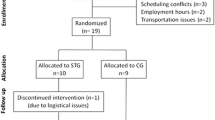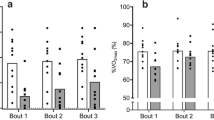Abstract
We hypothesized that endurance athletes have lower muscle power than power athletes due to a combination of weaker and slower muscles, while their higher endurance is attributable to better oxygen extraction, reflecting a higher muscle oxidative capacity and larger stroke volume. Endurance (n = 87; distance runners, road cyclists, paddlers, skiers), power (n = 77; sprinters, throwers, combat sport athletes, body builders), team (n = 64; basketball, soccer, volleyball) and non-athletes (n = 223) performed a countermovement jump and an incremental running test to estimate their maximal anaerobic and aerobic power (VO2max), respectively. Dynamometry and M-mode echocardiography were used to measure muscle strength and stroke volume. The VO2max (L min−1) was larger in endurance and team athletes than in power athletes and non-athletes (p < 0.05). Athletes had a larger stroke volume, left ventricular mass and left ventricular wall thickness than non-athletes (p < 0.02), but there were no significant differences between athlete groups. The higher anaerobic power in power and team athletes than in endurance athletes and non-athletes (p < 0.001) was associated with a larger force (p < 0.001), but not faster contractile properties. Endurance athletes (20.6%) had a higher (p < 0.05) aerobic:anaerobic power ratio than controls and power and team athletes (14.0–15.3%). The larger oxygen pulse, without significant differences in stroke volume, in endurance than power athletes indicates a larger oxygen extraction during exercise. Power athletes had stronger, but not faster, muscles than endurance athletes. The similar VO2max in endurance and team athletes and similar jump power in team and power athletes suggest that concurrent training does not necessarily impair power or endurance performance.


Similar content being viewed by others
Abbreviations
- BFmax :
-
Maximal breathing frequency
- BM:
-
Body mass
- BMI:
-
Body Mass Index
- CV:
-
Coefficient of variation
- EF:
-
Ejection fraction
- FEV1 :
-
Forced expiratory volume in one second
- FVC:
-
Forced vital capacity
- Hb:
-
Hemoglobin
- HR:
-
Heart rate
- LV:
-
Left ventricle
- LVM:
-
Left ventricular mass
- MVC:
-
Maximal voluntary contraction torque
- PEF:
-
Predicted peak expiratory flow
- RWT:
-
Relative left cardiac ventricle wall thickness
- RWT:
-
Relative left ventricular wall thickness
- SV:
-
Stroke volume
- VEmax :
-
Maximal pulmonary ventilation
- VO2max:
-
Maximal oxygen uptake
- VTmax :
-
Tidal volume
References
Amann M (2012) Pulmonary system limitations to endurance exercise performance in humans. Exp Physiol 97(3):311–318. https://doi.org/10.1113/expphysiol.2011.058800
Bagley L, McPhee JS, Ganse B, Müller K, Korhonen MT, Rittweger J, Degens H (2019) Similar relative decline in aerobic and anaerobic power with age in endurance and power master athletes of both sexes. Scand J Med Sci Sports. https://doi.org/10.1111/sms.13404
Ballak SB, Buse-Pot T, Harding PJ, Yap MH, Deldicque L, de Haan A, Jaspers RT, Degens H (2016) Blunted angiogenesis and hypertrophy are associated with increased fatigue resistance and unchanged aerobic capacity in old overloaded mouse muscle. Age (Dordrecht) 38(2):39. https://doi.org/10.1007/s11357-016-9894-1
Bassett DR Jr, Howley ET (2000) Limiting factors for maximum oxygen uptake and determinants of endurance performance. Med Sci Sports Exerc 32(1):70–84
Boullosa DA, Abreu L, Varela-Sanz A, Mujika I (2013) Do olympic athletes train as in the Paleolithic era? Sports Med 43(10):909–917. https://doi.org/10.1007/s40279-013-0086-1
Chamari K, Ahmaidi S, Fabre C, Masse-Biron J, Prefaut C (1995) Anaerobic and aerobic peak power output and the force-velocity relationship in endurance-trained athletes: effects of aging. Eur J Appl Physiol Occup Physiol 71(2–3):230–234
Christou M, Smilios I, Sotiropoulos K, Volaklis K, Pilianidis T, Tokmakidis SP (2006) Effects of resistance training on the physical capacities of adolescent soccer players. J Strength Cond Res 20(4):783–791. https://doi.org/10.1519/R-17254.1
Degens H (2012) Determinants of skeletal muscle hypertrophy and the attenuated hypertrophic response at old age. Sports Med Doping Stud. https://doi.org/10.4172/2161-0763.s1:003
Degens H (2019) Human ageing: impact on muscle force and power. In: Zoladz JA (ed) Muscle and exercise physiology. Elsevier, London, pp 423–432
Degens H, Maden-Wilkinson TM, Ireland A, Korhonen MT, Suominen H, Heinonen A, Radak Z, McPhee JS, Rittweger J (2013) Relationship between ventilatory function and age in master athletes and a sedentary reference population. Age 35(3):1007–1015. https://doi.org/10.1007/s11357-012-9409-7
di Prampero PE, Ferretti G (1990) Factors limiting maximal oxygen consumption in humans. Respir Physiol 80(2–3):113–127
Erskine RM, Jones DA, Maffulli N, Williams AG, Stewart CE, Degens H (2011) What causes in vivo muscle specific tension to increase following resistance training? Exp Physiol 96(2):145–155. https://doi.org/10.1113/expphysiol.2010.053975
Erskine RM, Williams AG, Jones DA, Stewart CE, Degens H (2014) The individual and combined influence of ACE and ACTN3 genotypes on muscle phenotypes before and after strength training. Scand J Med Sci Sports 24(4):642–648. https://doi.org/10.1111/sms.12055
Eynon N, Birk R, Meckel Y, Lucia A, Nemet D, Eliakim A (2011) Physiological variables and mitochondrial-related genotypes of an athlete who excels in both short and long-distance running. Mitochondrion 11(5):774–777. https://doi.org/10.1016/j.mito.2011.05.009
Fagard R (2003) Athlete’s heart. Heart 89(12):1455–1461
Gilliver SF, Degens H, Rittweger J, Sargeant AJ, Jones DA (2009) Variation in the determinants of power of chemically skinned human muscle fibres. Exp Physiol 94(10):1070–1078
Grassi B, Cerretelli P, Narici MV, Marconi C (1991) Peak anaerobic power in master athletes. Eur J Appl Physiol Occup Physiol 62(6):394–399
Hagberg JM, Moore GE, Ferrell RE (2001) Specific genetic markers of endurance performance and VO2max. Exerc Sport Sci Rev 29(1):15–19
Harriss DJ, Atkinson G (2015) Ethical standards in sport and exercise science research: 2016 update. Int J Sports Med 36(14):1121–1124. https://doi.org/10.1055/s-0035-1565186
Hather BM, Tesch PA, Buchanan P, Dudley GA (1991) Influence of eccentric actions on skeletal muscle adaptations to resistance training. Acta Physiol Scand 143(2):177–185
Hickson RC, Dvorak BA, Gorostiaga EM, Kurowski TT, Foster C (1988) Potential for strength and endurance training to amplify endurance performance. J Appl Physiol 65(5):2285–2290
Karaliute R, Raugaliene R, Venckunas T (2011) Relationship between left ventricular structure and post-exercise blood pressure in endurance athletes. Acta Cardiol 66(3):359–363. https://doi.org/10.2143/AC.66.3.2114136
Kraemer WJ, Deschenes MR, Fleck SJ (1988) Physiological adaptations to resistance exercise: implications for athletic conditioning. Sports Med 6(4):246–256
Loturco I, Gil S, Laurino CF, Roschel H, Kobal R, Cal Abad CC, Nakamura FY (2015) Differences in muscle mechanical properties between elite power and endurance athletes: a comparative study. J Strength Cond Res 29(6):1723–1728. https://doi.org/10.1519/JSC.0000000000000803
Maden-Wilkinson TM, McPhee JS, Jones DA, Degens H (2015) Age-related loss of muscle mass, strength, and power and their association with mobility in recreationally-active older adults in the United Kingdom. J Aging Phys Act 23(3):352–360. https://doi.org/10.1123/japa.2013-0219
Malinauskas R, Dumciene A, Mamkus G, Venckunas T (2014) Personality traits and exercise capacity in male athletes and non-athletes. Percept Mot Skills 118(1):145–161. https://doi.org/10.2466/29.25.PMS.118k13w1
McKenzie DC (2012) Respiratory physiology: adaptations to high-level exercise. Br J Sports Med 46:381–384. https://doi.org/10.1136/bjsports-2011-090824
Michaelis I, Kwiet A, Gast U, Boshof A, Antvorskov T, Jung T, Rittweger J, Felsenberg D (2008) Decline of specific peak jumping power with age in master runners. J Musculoskelet Neuronal Interact 8(1):64–70
Mueller G, Perret C, Hopman MT (2008) Effects of respiratory muscle endurance training on wheelchair racing performance in athletes with paraplegia: a pilot study. Clin J Sport Med 18(1):85–88
Nielsen HB (2003) Arterial desaturation during exercise in man: implication for O2 uptake and work capacity. Scand J Med Sci Sports 13(6):339–358
Omairi S, Matsakas A, Degens H, Kretz O, Hansson KA, Solbra AV, Bruusgaard JC, Joch B, Sartori R, Giallourou N, Mitchell R, Collins-Hooper H, Foster K, Pasternack A, Ritvos O, Sandri M, Narkar V, Swann JR, Huber TB, Patel K (2016) Enhanced exercise and regenerative capacity in a mouse model that violates size constraints of oxidative muscle fibres. Elife. https://doi.org/10.7554/elife.16940
Powers SK, Coombes J, Demirel H (1997) Exercise training-induced changes in respiratory muscles. Sports Med 24(2):120–131
Saltin B, Gollnick PD (1983) Skeletal muscle adaptability: significance for metabolism and performance. In: Peach LO (ed) Handbook of physiology. American Physiological Society, Bethesda, pp 555–629
Spengler CM, Boutellier U (2000) Breathless legs? Consider training your respiration. News Physiol Sci 15:101–105
Van Damme R, Wilson RS, Vanhooydonck B, Aerts P (2002) Performance constraints in decathletes. Nature 415(6873):755–756. https://doi.org/10.1038/415755b
van Wessel T, de Haan A, van der Laarse WJ, Jaspers RT (2010) The muscle fiber type-fiber size paradox: hypertrophy or oxidative metabolism? Eur J Appl Physiol 110(4):665–694
Venckunas T, Lionikas A, Marcinkeviciene JE, Raugaliene R, Alekrinskis A, Stasiulis A (2008) Echocardiographic parameters in athletes of different sports. J Sports Sci Med 7(1):151–156
Venckunas T, Vasiliauskas D, Marcinkeviciene JE, Grizas V, Stasiulis A, Malkova D (2011) Strongmen sport is associated with larger absolute heart size and impaired cardiac relaxation. J Strength Cond Res 25(10):2919–2925. https://doi.org/10.1519/JSC.0b013e31820f50ef
Venckunas T, Emeljanovas A, Mieziene B, Volbekiene V (2017) Secular trends in physical fitness and body size in Lithuanian children and adolescents between 1992 and 2012. J Epidemiol Community Health 71(2):181–187. https://doi.org/10.1136/jech-2016-207307
Vikmoen O, Raastad T, Seynnes O, Bergstrom K, Ellefsen S, Ronnestad BR (2016) Effects of heavy strength training on running performance and determinants of running performance in female endurance athletes. PLoS One 11(3):e0150799. https://doi.org/10.1371/journal.pone.0150799
Wasserman K, Hansen J, Sietsema K, Sue DY, Stringer W, Sun X-G, Whipp B (2005) Principles of exercise testing and interpretation, 5th edn. Lippincott Williams & Wilkins, Philadelphia
Wisloff U, Castagna C, Helgerud J, Jones R, Hoff J (2004) Strong correlation of maximal squat strength with sprint performance and vertical jump height in elite soccer players. Br J Sports Med 38(3):285–288
Wohlgemuth M, van der Kooi EL, Hendriks JC, Padberg GW, Folgering HT (2003) Face mask spirometry and respiratory pressures in normal subjects. Eur Respir J 22(6):1001–1006
Zhou B, Conlee RK, Jensen R, Fellingham GW, George JD, Fisher AG (2001) Stroke volume does not plateau during graded exercise in elite male distance runners. Med Sci Sports Exerc 33(11):1849–1854
Acknowledgements
We thank all participants for taking part in the study.
Funding
The study was funded by the Lithuanian Sports University.
Author information
Authors and Affiliations
Contributions
HD, AS, AS, BS, and TV conceived the study and collected the data. HD and TV performed the analyses. All authors discussed the results and contributed to the writing of the manuscript.
Corresponding author
Ethics declarations
Conflict of interest
None of the authors has any conflicts of interest.
Additional information
Communicated by Guido Ferretti.
Publisher’s Note
Springer Nature remains neutral with regard to jurisdictional claims in published maps and institutional affiliations.
Rights and permissions
About this article
Cite this article
Degens, H., Stasiulis, A., Skurvydas, A. et al. Physiological comparison between non-athletes, endurance, power and team athletes. Eur J Appl Physiol 119, 1377–1386 (2019). https://doi.org/10.1007/s00421-019-04128-3
Received:
Accepted:
Published:
Issue Date:
DOI: https://doi.org/10.1007/s00421-019-04128-3




